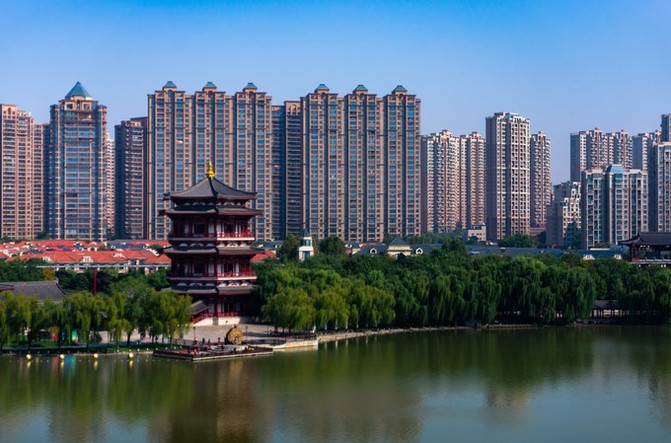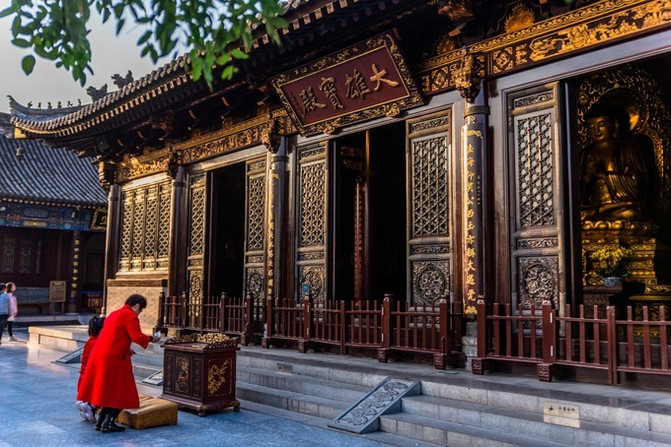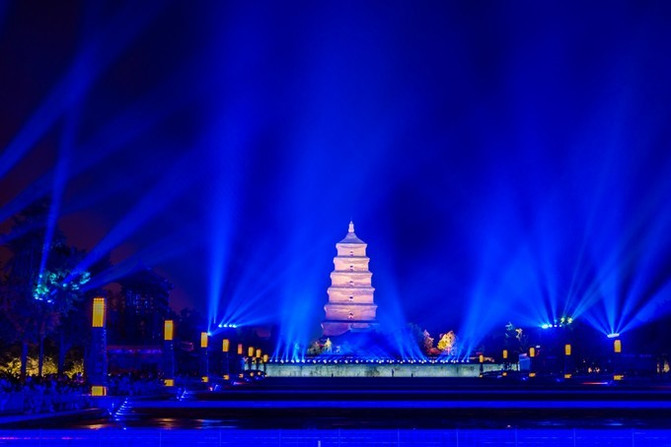Xi'an trip| Inheriting the ancient charm and recalling the prosperous times of the Tang Dynasty
preface
"If you want to see China's five hundred years, please go to Beijing; if you want to see China's five thousand years, please go to Xi'an." Seeing this, you should know that Xi'an has a long history. Xi'an was the capital of thirteen dynasties and was also one of the seven ancient capitals of China. One of the ancient capitals, it is also known as the "Four Great Ancient Capitals of Civilizations in the World" together with Athens, Cairo and Rome.
Xi'an was called Chang' an in ancient times. The imperial tombs, palace ruins, ancient temples and gardens all over Xi'an make Xi'an a treasure house of history and culture. Countless cultural relics and monuments show people its once glory and profound and rich historical and cultural charm.
Traveling in October, the RV exploration tour officially began. Walking into Xi'an, you will experience the vicissitudes of China over the past few thousand years, as well as the development of Chinese civilization and the greatness of the Chinese nation.

The Furong Garden of the Tang Dynasty was built along the Qujiang River during the Qin Dynasty, and was renamed the Furong Garden during the Sui Dynasty. It was drunk by a light boat, and the flow of letters was led to the depths of the flowers. Climbing the Ziyun Tower, you can look at Chang 'an. In the Tang Dynasty, Qujiang entered a period of prosperity. At that time, Furong Garden was turned into a royal forbidden garden-Furong Garden (also known as Furong Garden), and important buildings such as Ziyun Tower and Caixia Pavilion were built in the 14th year of Kaiyuan of the Tang Dynasty. In order to visit Qujiang Furong Garden frequently, Emperor Xuanzong of the Tang Dynasty built a special city along the city wall from the imperial palace to the Furong Garden. At every Qujiang Conference, Emperor Minghuang of the Tang Dynasty brought his favorite concubine and hundreds of officials to the Ziyun Building of Furong Garden to have fun with the people. Tang Chang 'an City was empty of thousands of people, and everyone gathered happily in Qujiang for a banquet, which can be seen in the grand occasion of the Tang Dynasty.


Walking into the west gate, you can see a huge jade seal engraved with the five characters of Tang Dynasty Furong Garden. The ground below the jade seal is covered with the five characters. The jade seal symbolizes feudal imperial power, and Furong Garden is also the royal garden of the Li Tang Dynasty. The jade seal sculpture also exaggerates the grandeur of the royal garden from an artistic and aesthetic perspective.

Furong Lake in the park has a wide water surface and rippling blue waves. The shape is convex in the north and concave in the south, showing the shape of a "waist moon" and surrounding Ziyun Building.
When the calm is calm, the reflections of Ziyun Tower and surrounding buildings can be seen. The changes in movement and the myriad weather are making people feel relaxed and happy.



The Ziyun Building located in the center of the park is the main building of the Tang Dynasty Furong Garden and the largest imitation of the Tang Dynasty royal building in China. The Ziyun Tower in history is reportedly built in the 14th year of Kaiyuan in the Tang Dynasty. The Jade Tower and Golden Hall are tall and tall, overlooking the oasis and winding waters, and overlooking the undulating mountains of Zhongnan. At every Qujiang Conference in those years, the emperor climbed this building, leaned on the railing to watch the scenery, enjoyed the light songs and dances of the pear garden, and gave banquets to the imperial concubines and favorite ministers. At the same time, he could watch and watch all the people traveling together in the Qujiang Pool, with the intention of having fun with the people.


On the ground in the center of the South Square, there is also a "Tang Territory Map" made of 992 copper plates. The Tang Dynasty was strong and had a vast territory. It reached the Aral Sea in the west, Lake Baikal in the north, Hailing Sakhalin Island in the east, and southern Vietnam in the south. It shows the territory of the Tang Dynasty at that time and the main prefectures and prefectures within it.


Climbing up the Ziyun Tower, everything you can see is beautiful scenery. The ancient royal garden, the surrounding high-rise buildings, and the solemn Big Wild Goose Pagoda in the distance jointly draw a prosperous Chang 'an that spans thousands of years.

Xi'an Shaanxi Expo Hall
The land of Sanqin is one of the important areas where the Chinese nation lived and thrived, and where Chinese civilization was born and developed. Thirteen dynasties, including the most glorious Zhou, Qin, Han, and Tang dynasties in Chinese history, once established their capitals here. If you want to understand these long history and culture, you must go to the Shaanxi Expo Hall. The rich cultural relics and profound cultural heritage inside have formed Shaanxi's unique historical and cultural features. The Shaanxi History Museum, known as the "Pearl of the Ancient Capital and the Treasure House of China", is an art palace displaying Shaanxi's history, culture and ancient Chinese civilization.



Shaanxi History Museum is located on the northwest side of the Big Wild Goose Pagoda in Xi'an. It is China's first large-scale modern national-level museum. The former building is a Tang-style building with "central hall and four corners". The primary and secondary buildings are orderly, with high and low, and the momentum is majestic and solemn, integrating national traditions, local characteristics and the spirit of the times. There are 1717950 cultural relics (groups) in the collection, ranging from simple stone tools used in the initial stage of ancient humans to various artifacts in social life before 1840, covering a period of more than one million years. Cultural relics are not only large in number and variety, but also of high quality and wide in value. Among them, the bronze wares of the Shang and Zhou Dynasties are exquisite. The pottery figurines of the past dynasties are in various shapes. The gold and silver wares of the Han and Tang Dynasties are unique in the country, and the wall paintings of Tang tombs are unparalleled in the world. It can be described as a dazzling array of high-quality products.



The special display of the Tang Dynasty's relics-the exhibition of unearthed cultural relics from the Hejiacun Cellar Collection is located in the fourth exhibition hall. Starting from the shocking discoveries of the Hejiacun Cellar Collection, 257 pieces (groups) of unearthed precious cultural relics are gathered, showing the style of the times in the prosperous Tang Dynasty from the aspects of culture, economy, customs, etc. The special display of "Tang Dynasty Mural Treasures Hall" is located on the second underground floor of the East Exhibition Hall. In accordance with the principle of "replacing collection with exhibitions", 97 fine murals from Tang tombs are displayed, vividly depicting the etiquette norms, living customs, and clothing characteristics of the Tang Dynasty., entertainment methods and architectural styles show the social life of the Tang Dynasty, especially the life of the aristocrats, and their spiritual world.




Xi'an Big Wild Goose Pagoda
When you come to Xi'an, you must go to the Big Wild Goose Pagoda. In the third year of Yonghui of Emperor Gaozong of the Tang Dynasty, Xuanzang petitioned to build the Wild Goose Pagoda, which would be completed in October. At first, the tower was five-story, with a brick topsoil core. From 701 to 704 AD, during the Tianchang 'an period of Wuze, it was rebuilt into a seven-story pavilions-style brick tower, which has been preserved to this day. The tower was built to preserve the Sanskrit scriptures of Bedoro leaves retrieved from India, and more than 10,000 relics were buried.


The Big Wild Goose Pagoda was built because of the temple and has stood in Cien Temple for thousands of years. Cien Temple is also a must-visit for tourists. You can reach the bottom of the Big Wild Goose Pagoda from the main entrance and through the main hall. Ci 'en Temple is full of incense, and many tourists come here to petition piously.



The Big Wild Goose Pagoda is a pavilions style brick tower with a square cone body and has the style of traditional Chinese architectural art. The tower is 64 meters high and has a total of seven floors. The tower body is made of bricks and has stairs spiraling upwards. There is an archway entrance on the four sides of each floor. Looking back on the railing and looking into the distance, you can have a panoramic view of Chang 'an. There are stone doors on all sides on the ground floor of the tower, and there are exquisite line-carved Buddha statues on the lintel. It is said that it was written by Yan Liben, a great painter of the Tang Dynasty.


There are steles on both sides of the south gate on the ground floor of the tower. On the left is the "Preface to the Holy Religion of the Great Tang Sanzang" stele written by Li Shimin, Emperor Taizong of the Tang Dynasty, and handwritten by the great calligrapher Chu Suiliang. On the right is the "Preface to the Holy Religion of the Great Tang Sanzang" stele written by Li Zhi, Emperor Gaozong of the Tang Dynasty and handwritten by Chu Suiliang. These two steles were erected here by Xuanzang himself in October of the fourth year of Yonghui of Emperor Gaozong of the Tang Dynasty (653), and are still intact. It is worth mentioning that Tang Dynasty painters Wu Daozi and Wang Wei once painted many murals for Cien Temple, but unfortunately they have long been lost in history. However, exquisite Tang Dynasty line carvings are still preserved on the stone lintels and doorframes of the four entrances under the Dayan Pagoda.


datang sleepless city
The charm of Xi'an is not limited to the graceful ancient charm of the day. At night, Xi'an's prosperous times begin to spread. From the Tang Dynasty to cash, Xi'an is a city that never sleeps. There are many people in front of the Cien Temple Square, which is more and more lively than during the day.


Waiting tourists have gathered early in the Big Wild Goose Pagoda Square, and a grand light and water dance show is about to be staged. Light and shadow are intertwined, water dances are exquisite, and music reverberates in Xi'an for a long time.



After the light and water dance show, many people lined up two or three hours in advance for the performance of the Internet celebrity tumbler. Unfortunately, they couldn't see it. No matter what time, the Tang Dynasty Sleepless City is always crowded with people. The streets are brightly lit and neon lights are flashing, as if you are really in the prosperous times of the Tang Dynasty.



Qin Emperor Terracotta Warriors and Horses
The Mausoleum of the First Emperor of Qin is located in Lintong District, Xi'an City, Shaanxi Province. It borders Mount Li in the south and Wei River in the north. The tomb is tall and majestic, like a towering hill at a glance. The Qin Terracotta Warriors and Horses Pit is located 1.5 kilometers east of the tomb of Qin Shihuang. Pit No. 1 was accidentally discovered by local farmers while digging wells in the spring of 1974. Later, after excavation and exploration by an archaeological team, two more pits were discovered one after another. According to the order of discovery, they were divided into Pit 1, Pit 2, and Pit 3. The three pits are all underground tunnel-type civil structural buildings with a total area of more than 20,000 square meters. They contain nearly 8000 ceramic terracotta warriors and more than 100 chariots. They simulate the establishment of ancient troops and form a huge military scene, which is rare in ancient and modern history at home and abroad.

Among the three terracotta warriors pits, the largest is Pit No. 1, with a total area of 14260 square meters. According to estimates, more than 6000 pottery figurines and horses can be unearthed, which are a rectangular military formation composed of mixed tanks and infantry. It consists of four parts: vanguard, main body, flank and defender. There are three rows of warrior figurines facing east in the corridor at the eastern end of the pit, with 68 pieces in each row, totaling 204 pieces. Most of these warriors were dressed in combat robes, holding bows and crossbows, and faced east, forming the vanguard of this army formation. On the south and north sides of the pit, there are a row of warrior terracotta faces south and north, forming the flank of this military formation. At the western end of the Wukeng, there is also a row of warriors facing west, forming the defender of this military formation. There are 38 columns in the middle of Yukeng, all composed of infantry and chariot soldiers, which shows that this military formation is tightly organized and complete, reflecting the square formation with "neat front and back, and ropes in all directions" as described in ancient military books.



Pit 2 is the most complex, covering an area of 6000 square meters. Based on drilling and local trial excavation, more than 1300 terracotta warriors and more than 80 wooden chariots can be unearthed in Pit 2. It is a large-scale military formation composed of chariots, infantry, cavalry and crossbowmen.


Pit No. 3 has the smallest area, only 520 square meters. According to experts, it may be the location of the command office of the entire underground army. These three pits simulate the arrangement of ancient military formations, forming a huge military scene, symbolizing the Suwei Army guarding the Qin Mausoleum. This kind of leadership organization that has both a powerful military formation that "wins the battle thousands of miles away" and "plans in the midst of strategies" is really thoughtful and well-planned. After seeing the Qin Terracotta Warriors and Horses, the knowledgeable American Dr. Kissinger said: "The military level of the Qin Dynasty in China was 300 years advanced than that of ancient Rome."



In addition to the three pits, there is also an exhibition hall of copper chariots and horses. The copper chariots and horses were one of the burial objects of Qin Shi Huang and symbolized part of Qin Shi Huang's chariot. The shape of the copper chariots and horses imitates the shape of a real chariot. The carriages discovered in the past were all wooden and decayed when unearthed. The excavation of copper chariots and horses allows us to clearly see the true appearance of ancient royal carriages. The copper chariots and horses were made by reducing the proportion of one-half of the chariots in the imperial fleet of Qin Shi Huang. The covers and the inside and outside of the carriages were painted with exquisite patterns; the gold and silver ornaments on the two copper chariots and horses weighed 14 kilograms, showing the noble rank of the copper chariots and horses.



When you are proud of the spring breeze, you can see all Chang 'an flowers in a day. Looking at the legacy of ancient charm and recalling the prosperous times of the Tang Dynasty, I dream of Chang 'an this autumn.


Previous Article:It's not a weekend, but you can also relax-drive Kopachi to Yuechuan Hot Spring Hotel #Kopachi Experiencer #
Next Article:Looking for "visit" cultural relics in the forest of steles| What fine jade pieces are hidden in Xi'an Museum?
